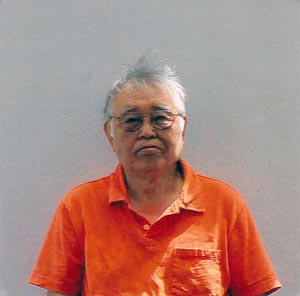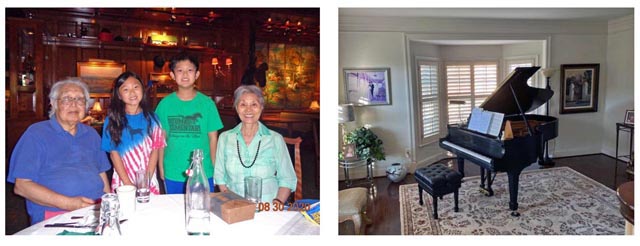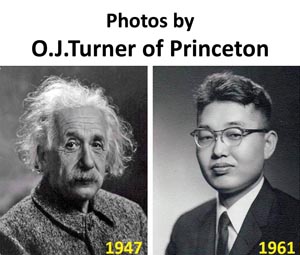Lifetime Achievement byYoung Suh Kim
|
Summary
- Einstein and Wigner. While I was at Princeton (1958-62) as a grduate student
and as a postoctoral fellow, I became interested in
Eugene Paul Wigner's 1939 paper on internal space-time symmetries of particled in Einstein's
Lorentz-covariant world. I studied hard, and I was fortunate enough to talk with Wigner.
However, I could not completely understand its historical role in physics. I am not
the only one who had difficulties with this paper. In 1963, Wigner received the Nobel Prize
in physics, but the pize was not specifically for this paper.
In 1962, I joined the faculty of the University of Maryland, but I continued studying this paper, and published the following papers.
- 1983. Gauge transformations as Lorentz-Boosted rotations,
with D. Han and D. Son,
Phys. Lett. B [131], 327 - 329. - 1986. Eulerian Parametrization of Wigner's Little Groups and Gauge
Transformations in term of Rotations of Two-component Spinors,
with D. Han and D. Son,
J. Math. Phys. [27], 2228 - 2236.
The contents of these papers can be summarized as
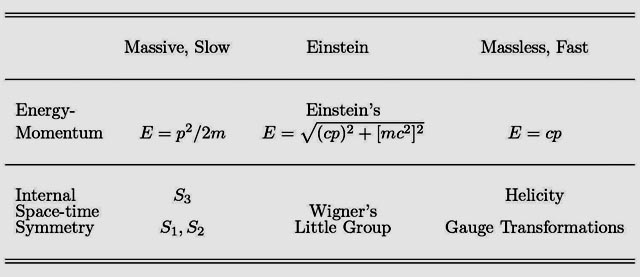
- In 1986, I approached Professor Wigner and showed this table. Wigner was so happy that he invited me to write new papers with me. As a result, we published the following two papers on this subject.
- 1987. Cylindrical group and massless particles,
J. Math. Phys. [28], 1175 - 1179 (1987). - 1990. Space-time geometry of relativistic particles
J. Math. Phys. [31], 55 - 60 (1990).
These papaers allows me to place myself in the followinf figure.
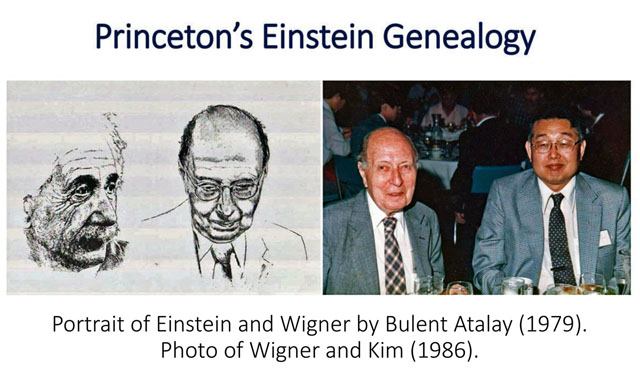
- During the summer of 1971, Mailyn Noz visited the University of Maryland. With her, I started studying hemoinc oscillator wave functions applicable to the quark model. We noted that Richard Feyman, in 1971 with his students, published a paper in the Physical Review D. This paper is known in as the FKR psprer. The authors of thie FKR paper were interested in constructing harmonic oscillator wave functions in Einstei's Lorentz-covariant world. They wrote down a Lorentz-invariant differential equation which remains the same for moving bound states. However, they fail to see that the wave function can take different forms. As a consequence, they wrote down wave functions that cannot be normalised, and theit wave fuctions do not make sense in quantum mechanics.
It was quite unfortunate for these authors that normalizable solutions existed in the literature when they wrote their paper. In 1973, with Marilyn Noz, I published a paper our first paper on the Lorentz-covariant harmonic oscillators. Click here for the paper. In 1977, using this covariant oscillator wave function, we proved that Gell-Mann's quark model for the proton and Feynman's parton picture of the untra-fast proton are two different ways of looking at the same enity in Einstein's Lorentz-covariant world. Click here for the paper on this result.
- I continued studying the oscillator wave functions within the framework Wigner's 1939 paper on his little groups with a graduate student at the University of Maryland, but he did not like what I was doing, and told me not to mention his name in the paper. I had to publish a single-authored paper in Physical Review Letters containig the this table:
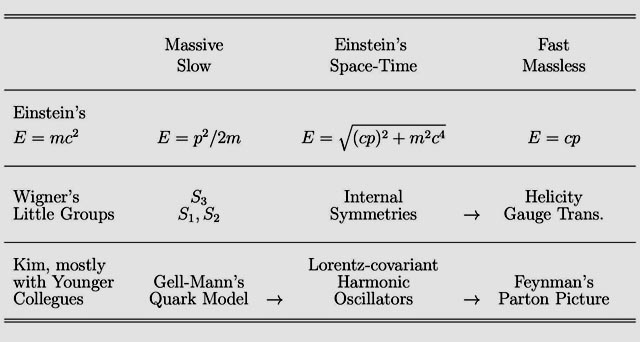
I am primarilly responsible for the three arrows in this paper. - 1983. Gauge transformations as Lorentz-Boosted rotations,
Historical Significance
- One hundred years ago, Niels Bohr was studying the electron orbit of the hydrogen atom.
He found that its energy levels are discrete and not continuous. This research led to
the present form of quantum mechanics.
Albert Einstein was worrying about how things look to moving observers. This led to his special theory of relativity with his celebrated formula E = mc2.
The question then is how Bohr's hydrogen atom appears to moving observers. Bohr and Einstein met occasionally to discuss physics, but there are no written record indicating that they ever discussed this issue. Perhaps, they never did because there are no hydrogen atoms moving fast enough to exhibit this Bohr-Einstein puzzle.
-
Physics is an experimental science. There are no observable hydrogen atoms moving with
relativistic speed. Thus, the Bohr-Einstein issue remained as only as a metaphysical
question. After 1950, particle accelerators started producing protons moving with speeds
close to that of light. However, protons are not moving hydrogen atoms.
- In 1964, Murray Gell-Mann proposed (Nobel 1969) the quark model. According to this model,
the proton is a quantum bound state of the more fundamental particles called the "quarks."
In 1969, Richard Feynman (Nobel 1965) observed that the proton, when it moves with a speed
close to that of light appears like a collection of partons whose properties are quite different
those of Gell-Mann's quarks.
- Since the proton is a quantum bound state just like the hydrogen atom, the resolution of this quark-parton issue of the proton is the resolution of the Bohr-Einstein issue of the hydrogen atom.
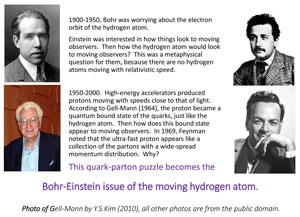 Click here to expand this figure.
Click here to expand this figure.
- In 1964, Murray Gell-Mann proposed (Nobel 1969) the quark model. According to this model,
the proton is a quantum bound state of the more fundamental particles called the "quarks."
In 1969, Richard Feynman (Nobel 1965) observed that the proton, when it moves with a speed
close to that of light appears like a collection of partons whose properties are quite different
those of Gell-Mann's quarks.
- I like to be remembered as the person who resolved this Bohr-Einstein issue, by showing
that Gell-Mann's proton and Feynman's proton are two different cases (one at rest and the other
moving with the ultra-speed) of one Lorentz-covariant entity in Einstein's world. With Marilyn
Noz, I published a paper on this issue in the
Physical Review in 1977. I then published the reinforcement of this
result in
Physical Review Letters in 1989.
- What scientific background did I have to tackle this issue?
I was a graduate student at Princeton University from 1958 to 1961. I stayed there for one additional year until 1962. While there, I started studying the paper Eugene Wigner (Nobel 1963) published in 1939 on internal space-time symmetries. Click here for the paper. This paper is dearest to Wigner's heart, but it is extremely difficult to understand its true contents. His 1963 Nobel citation did not mention the contribution Wigner made in this paper. I made efforts to understand this paper while I was a student at Princeton and continued my effort to decode this paper, even after I left Princeton.
In 1986, with my younger colleagues, I published a paper containing the following table.
This table tells that Wigner's little group unifies the internal space-time symmetries for both massive and massless particles, as Einstein's world.
-
E = mc2
unifies the energy-momentum relation. This table is from one of my papers published in 1986. My co-authors were D. Han and D.Son.
In 1986, I showed this table to Professor Wigner, and we continued the research on his 1939 paper. We published a number of papers together, and our final paper was published in 1990. Click here for the paper.
- This table allows us to place the Bohr-Einstein or the quark-parton issue as
a continuation of Einstein's energy-momentum relation known as
E = mc2.
Integration of Paul A. M. Dirac's efforts to construct wave functions for moving bound states.
- In 1962, I was appointed as an assistant professor of physics at the University
of Maryland. In the same year,
Paul A. M. Dirac (Nobel 1933) visited the University for one week. Since
I was the youngest faculty member, I was
assigned to be his personal assistant.
This gave me the opportunity to learn directly from him.
Dirac is well known for his Dirac equation, but his life-long interest was in understanding localized objects in Einstein's world. The hydrogen atom is not a point particle, but is localized object with a space-time extension. Dirac published four important papers on this subject. He published in papers in 1927, 1945, 1949, and in 1963.
I was able to integrate the first three papers to produce the following result.
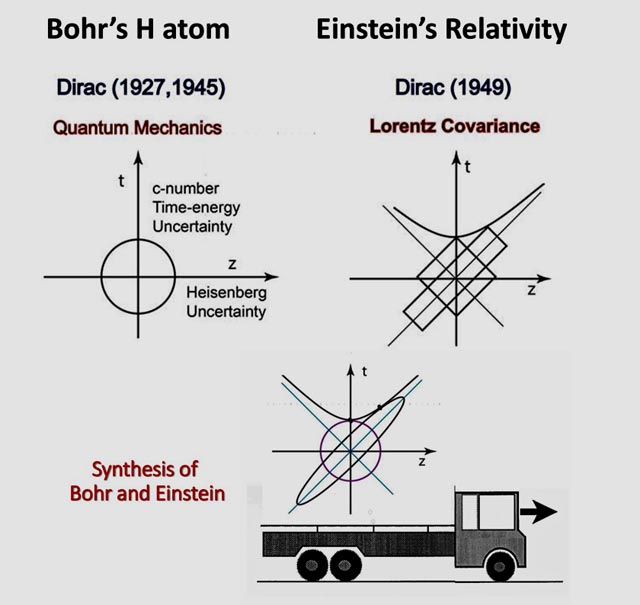
This picture allows us to resolve the quark-puzzle issue of Gell-Mann and Feynman, and the Bohr-Einstein issue of the moving hydrogen atom, as shown in the following figure.
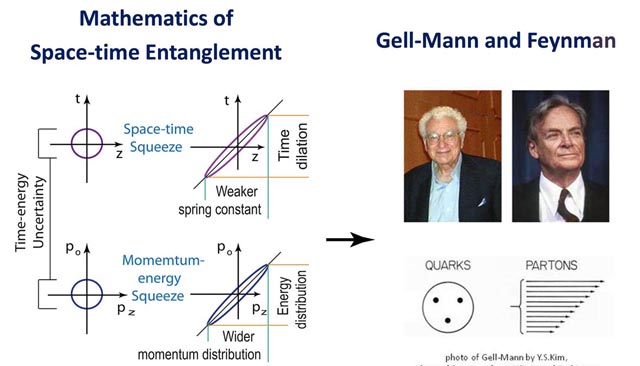 You may enlarge this figure by clicking on it.
You may enlarge this figure by clicking on it.
This result allows us to add the quark-parton row to the table given above. The result is
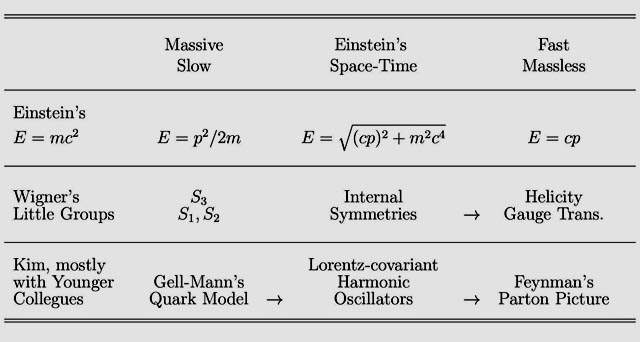 This table was published in my
PRL paper of 1989. I am primarily responsible for the three arrows given
in this table.
This table was published in my
PRL paper of 1989. I am primarily responsible for the three arrows given
in this table.
- As for Dirac's 1963 paper, he starts with two oscillators. He then concluded that the symmetry property is like the Einstein's system of space and time. The only difference is is that there are two time variables. It is then a challenge to convert the second time variable to another convenient variable. It is then possible to Einstein's special relativity from Heisenberg's uncertainty brackets. This means that quantum mechanics and special relativity can be derived from one basket of equations. Click here for a published paper on this subject.
Thus, we come to the following table for the history of physics.
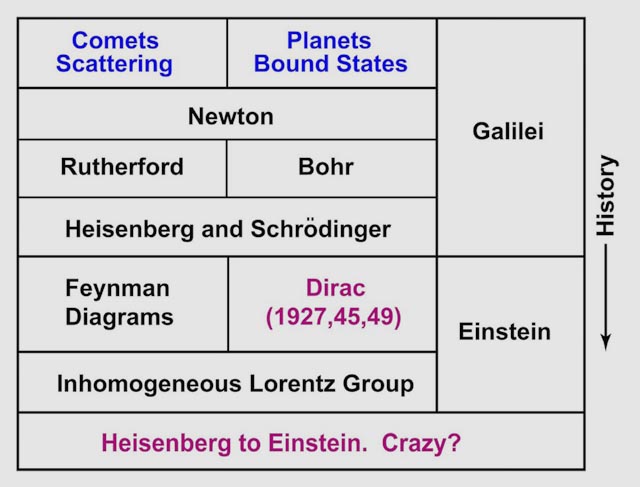
- As for Dirac's 1963 paper, he starts with two oscillators. He then concluded that the symmetry property is like the Einstein's system of space and time. The only difference is is that there are two time variables. It is then a challenge to convert the second time variable to another convenient variable. It is then possible to Einstein's special relativity from Heisenberg's uncertainty brackets. This means that quantum mechanics and special relativity can be derived from one basket of equations. Click here for a published paper on this subject.
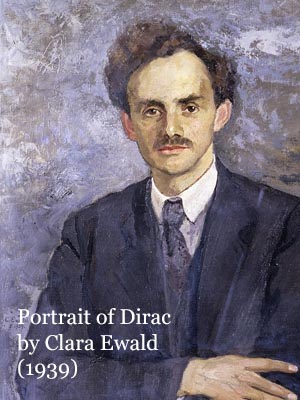
|
Not crazy. Physics is Art of Synthesis.
- Let us look at the Wigner function of the single harmonic oscillator.
This is one way of interpreting Heisenberg's uncertainty relation.
This wave function is a Gaussian function of in the two-dimensional
space of x and p. We can thus start with a circular distribution.
This wave function can be rotated and squeezed, as shown in
this figure.
- The algebra of this is the same as that of Lorentz transformations
applicable to two spacial directions one time dimension. Not enough for
the transformations applicable to three space dimensions and one time
dimensions.
- In his paper of 1963, Dirac considered two oscillators, and ended
up Lorentz transformations applicable to three space dimensions, and
two time variables. We do not need the two time variables.
- Thus it is possible to transform the second time variable into the
translational symmetry as shown in this figure.
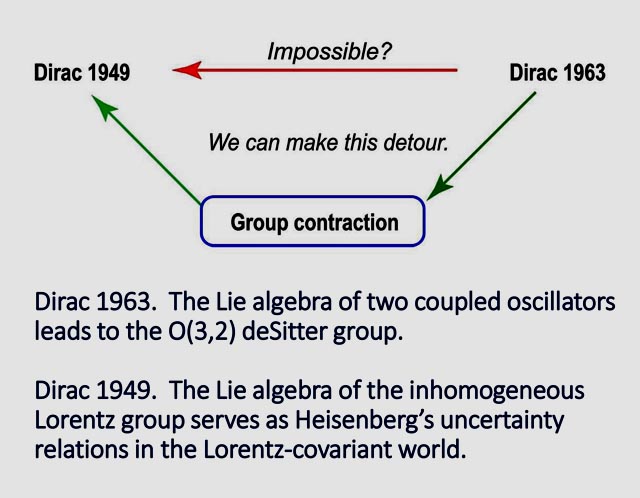
- Indeed, my recent papers are on this issue. On this issue, you may check my my publication list. Here are two important Dirac pulished.
- In his 1949 paper, Dirac stated that the construction of quantum
mecancis is the task of obtaining a representation of the "inhomgenous
Lorentz group."
- In his 1963 paper, starting from the quantum mechanics of two coupled oscillators, Dirc constructed the Lorents group appliable to three space dimensions and two time variables.
In his 1949 paper, Dirac said the construction of quantum mechanics in Einstein's Lorentz-covariant world is the task of constructing a representation of the inhomogeneous Lorentz group. In his 1963 paper, he starts with two harmonic oscillators, and ends up with the O(3,2) deSitter group.
- The O(3,2) deSitter group is the Lorentz group applicable to three space dimensions and two time dimensions. Einstein's Lorentz group is applicable to three space dimensions x, y, z, and one time variable t. The O(3,2) is applicable to the three-dimensional xyz space plus two time variables t and s. The problem is how to transform the second time variable s into the useful variable in Einstein's space of x,y,z, and t.
- As in the case of t, the s variable maintains the hyperbolic relation with the space coordinates x, y, and z. It maintains a circular relation with the first time variable t. These relations are shown in this figure:

- As is shown in the above figure, the second time variable can be "contracted" to the translations degrees of freedom applicable to the four-dimensional space-time, with one time variable.
The contraction means that the curves are elongated along the s direction until it becomes a horizontal line, and then come back to the original scale. This procedure known as the group contraction introduced by Inonu and Winger in 1953. The result is that the four s degrees of freedom become four translations along the x,y,z, and t directions. The result is then the "Inhomogeneous Lorentz group" Dirac mentioned in his 1949 paper.
- This procedure is highly technical, and you are invited to the following articles I published with my younger colleagues.
-
Physics of the Lorentz Group, Second Edition: Beyond High-energy Physics
and Optics,
with Sibel Baskal and Marilyn Noz,
by the IOP (British Institute of Physics). - Einstein's E = mc2 derivable from Heisenberg's Uncertainty Relations,
with Sibel Baskal and Marilyn Noz,
Quantum Reports [1(2)], 236 - 251 (2019),
doi:10.3390/quantum1020021,
arXiv:abs/1911.03818, For pdf with sharper images, click here. - Poincaré Symmetry from Heisenberg's Uncertainty Relations,
with S. Baskal and M. E. Noz,
Symmetry [11(3)], 236 - 267 (2019),
doi:10.3390/sym11030409,
arXiv: abs/1903.05348"> ArXiv.
- Indeed, my recent papers are on this issue. On this issue, you may check my my publication list. Here are two important Dirac pulished.
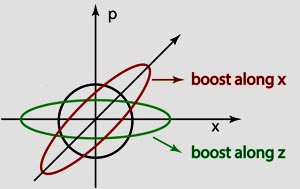
|
Let me explain my personal background.
Childhood (1935-1946)
- I was born in 1935 at a Korean village called Sorae, where
Koreans set up their first Presbyterian church in 1884. Horace
Underwood was the first American Presbyterian missionary who came to
Korea in 1885. Upon hearing about this church, he went to Sorae
and noted that this village is near a beautiful scenic beach called
Kumipo. He built his house there. Then, many other Americans
came to Kumipo to build their summer houses.
My grandfather was one of Underwood's trusted Korean friends. He was a well-to-do landlord, and took care of Underwood's properties at Sorae and Kumipo while he was busy in the capital city of Seoul. Underwood set up a Christian college in Seoul which became one of the leading universities in Korea, called Yonsei University.
I attended this Sorae church when I was a child, and grew up in the thoroughly Christian environment.
- Unfortunately, Korea became divided in 1945 after World War II, and
the village of Sorae is now under the control of the North Korean
regime which was installed in 1948 by Joseph Stalin of the Soviet
Union. My family moved to Seoul in 1946.
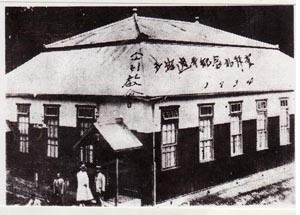
|
Click here for the history of this church. |
Teenager (1946-1954)
- In Seoul, I finished my elementary school and went to six
years of high school education from 1948 to 1954.
- Alas, the Korean War broke out in 1950 and lasted until 1953.
The school campus was
damaged and the students had to study at temporary places until the
cease fire was signed in July of 1953.
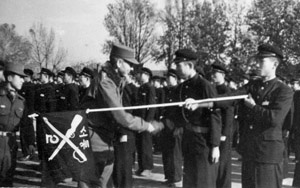 Click here to expand this photo.
Click here to expand this photo.
-
In this photo of 1954, I am shaking hands with General Maxwell
Taylor who was the commander of the U.S. Forces in Korea. Under him
were more than 300,000 combat-ready American troops.
General Taylor was a scholarly man and was keenly interested in Korea's educational system. He wanted to visit the best high school in Korea. He asked his Korean secretary which school to visit. The Korean secretary told Taylor about the high school he attended. He is also in this photo (far left).
- I liked mathematics during my my high school years. You have seen
above that my physics ideas were based on circles and ellipses. There
is a good reason.
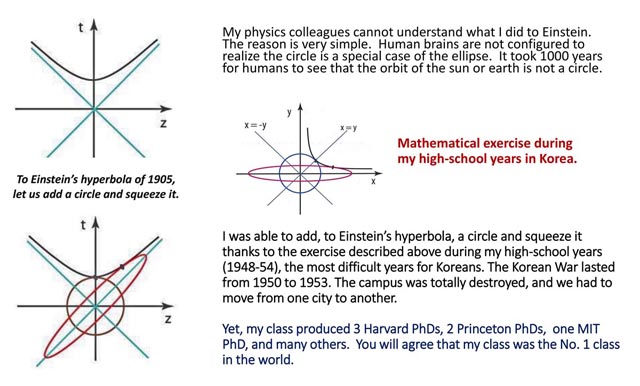 Click on the figure to enlarge it.
Click on the figure to enlarge it.
Undergraduate Years (1954-1958)
- In September of 1954, I came to the United States to become a
freshman at the Carnegie Institute of Technology (now called Carnegie
Mellon University) in Pittsburgh, Pennsylvania.
The life was not easy for me, but I worked hard enough to get excellent grades.
- On March 12, 1958, I received a letter from Princeton University
telling me I was one of twelve students admitted to the graduate
program in physics. This was the happiest day in my life. Going
to Princeton meant working with Albert Einstein, even though he
died in 1955, three years before 1958.
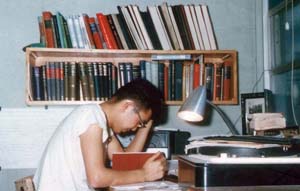 Click here to expand this photo.
Click here to expand this photo.
|
Princeton Years (1958-1962)
- In July of 1958, I went to Princeton for my graduate study.
Thanks to my solid high-school and undergraduate backgrounds, I
completed my PhD degree in three years, but I was asked to stay
there for one additional year as a post-doctoral fellow.
In this photo of 1961, I am making preparations for my third paper to be published in the Physical Review, the standard journal of the American physical Society.
Indeed, my Princeton background shaped up my research carrier. I went to Princeton in 1958 in order to meet Einstein, even though I knew he left us in 1955. Yet I was able to meet Eugene Wigner there. I was able to explain Wigner's work in terms of Einstein's E = mc2. I was then able to explain the quark-parton issue or Bohr-Einstein issue in terms of Wigner's 1939 paper on his little groups, as shown the two tables given above. I am thus justified to show the following genealogy.
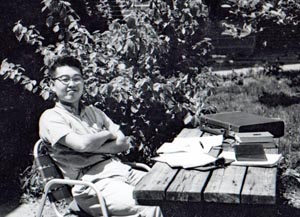
|
My life at the University of Maryland since 1962
- In July of 1962, I became an assistant professor of physics at
the University of Maryland, near Washington, DC. This is a
photo of the physics faculty
taken in the spring of 1963, and I am the youngest
person in this photo. The life was not easy for me in the highly
competitive academic world, where everybody is afraid of his/her
colleague becoming more famous than himself/herself.
- This is a human nature which can be described as
Herod Complex.
Among my colleagues, there were several people who got turned down from
Princeton and went to other good graduate schools. Those people were
extremely nasty to me. However, I always got help from appropriate
persons whenever I was in difficult positions. The point is that I
pursued my own research line strange to others.
What is the job of the youngest faculty member? In September of 1962, Paul A. M Dirac (Nobel 1933) visited the University of Maryland at the invitation of John S. Toll, the chairman of the Department of Physics. Toll assigned me to serve as the personal assistant to Dirac. This gave me the valuable opportunity to learn physics directly from him. Click here to see what learned from him.
- The most rewarding aspect of my life at the University of Maryland
is that the campus is near the city of Washington, DC.
There are many politicians in the Greater Washington area, but there are far more scientists in this area. They are providing necessary wisdom to the government. Here are the photos from this interesting city.
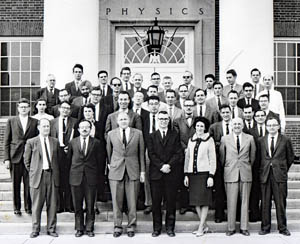 Click here to expand this photo.
Click here to expand this photo.
|
Personal History
- In Korea, the school year starts in March, while it begins in September
in the United States. Thus, I spent one freshman semester at the Engineering
College of Seoul National University, right after my
high school graduation until I started my freshman year at the
Carnegie Institute of Technology (in Pittsburgh. USA) in September of 1954.
At that time, Koreans did not trust female engineers. There were not many girls going to engineering colleges. In 1954, my freshman class consisted of 360 students, but there were only 15 girls. Among those girls, one of them appeared attractive to me.
- The following photos show the engineering college and the girl who
attracted my attention.
- I met this girl again in 1963 in Washington. By that time, she needed a
husband, and I needed a wife. We got married. We had our son in 1965,
and he went to Princeton as a freshman in 1983. He got married in 2003.
We now have two grandchildren.
- This is our family photo of 1966.
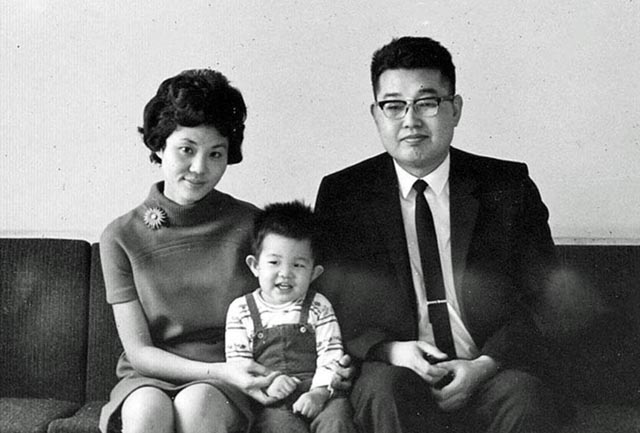
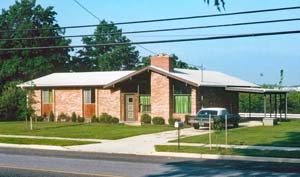
- In 1969, we bought a new house, and
we still live there. This house is about six km from the campus of
the University of Maryland. I could go to my office during the evening
hours.
- Our neighbors are nice people. They help us whenever we need helps. We once invited them to a Korean restaurant in the Washington area.
- There is a treed area near the house, and we see sometimes un-invited guests like this in our backyard.
- Click here for more house photos.
- We now have two grandchildren. Their parents (our son and his wife)
are doing well. In 2020, they bought a Steinway piano for our grandchildren.
We are proud of all four of them.
- Click here for webpages for my wife.
Life after 2007
|
I am a life-time student. I love students, and they love me! |
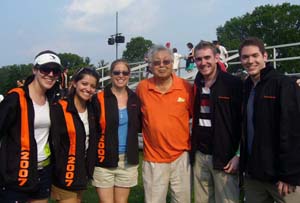
|
|
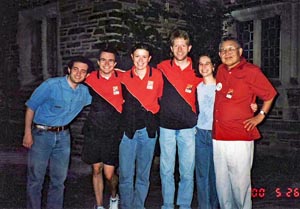
|
|
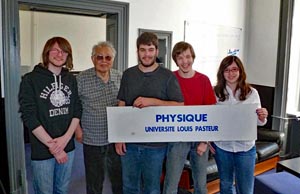
|
|
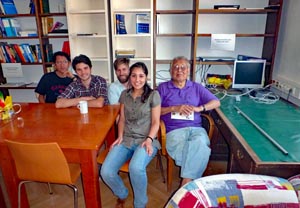
|
- In 2007, I became a professor emeritus at the Univ. of Maryland.
This could mean a retirement from professional life.
To me, however, it was a beginning of a new life. This means that I have no teaching and other scheduled duties. Thus, I became a full-time researcher, and I now publish books and articles with complete freedom. In addition, I could travel to interesting places in the world.
- I am free to say whatever I want to say. You may be interested in
the books and articles I published in recent years.
Click here for my publications.
- Since there are no scheduled duties, I have been free to travel around
the world and take photos.
Click here for the photos I took from many different countries. - I am now free to talk about Albert Einstein. Talking about Einstein
and other big names used to upset my colleagues and departmental
administrators in the past.
I am now free to talk about Einstein as a philosopher. Then, where is his coordinate among the well-known philosophers? Click here.
- I am free to say whatever I want to say. You may be interested in
the books and articles I published in recent years.
Click here for my publications.
- I realized that the most important aspect of my research has been and
still is to find out about myself, not necessarily about Einstein and others.
- Work Habit. Connect the existing
lakes to build a big canal. Paul A. M. Dirac wrote many papers in order
to make quantum mechanics consistent with relativity. But he never
attempted to combine them to make one big paper. It was a profitable
business for me to combine them into one paper. How could I do what
Dirac could not do? Dirac wrote beautiful sentences, and his papers
are poems. I translated his papers into cartoons (figures). Then
it is easy to combine them into
one picture
- Where do I stand in Physics? After many years
of struggle (before 2000), I found out where I stand in physics.
- I then became more
ambitious. I could integrate physics.
- During the 20th Century, scientists developed quantum mechanics (via Bohr and Heisenberg) and relativity (via Einstein). The question is whether these two theories can be derived from one basket of equations. I am writing papers and books on this unthinkable problem. Click here for my recent articles books.
- Work Habit. Connect the existing
lakes to build a big canal. Paul A. M. Dirac wrote many papers in order
to make quantum mechanics consistent with relativity. But he never
attempted to combine them to make one big paper. It was a profitable
business for me to combine them into one paper. How could I do what
Dirac could not do? Dirac wrote beautiful sentences, and his papers
are poems. I translated his papers into cartoons (figures). Then
it is easy to combine them into
one picture
- As a cultured man, I pretend to know about art and music. I can now
say that physics is an art of Harmony and Integration
(Tao and Hegel). Let us see harmony and integration in art and music.
- Harmony in Architecture and Harmony in Physics.
Let us look at the Jefferson Memorial in Washington, DC (USA). It is harmony and
synthesis of Greek columns and Roman dome. This building was John F. Kennedy's favorite
art piece.
- Harmony in Music and Harmony in
Physics. You are invited to my Beethoven
page, Go to his String Quartet No. 4. You will appreciate how important
"harmony" is in music.
- Feynman's One Physics. Feynman is my hero in physics. Like him, I believe in one physics. Richard Feynman was a great American physicist. He received his PhD degree from Princeton in 1942. I maintain a webpage dedicated to him. Click here. Feynman is also a very interesting individual.

Thomas Jefferson Memorial
in Washington, DC. USA.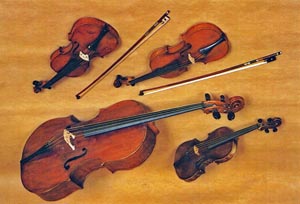
post card from the Beethoven Museum
in Bonn, Germany. - Harmony in Architecture and Harmony in Physics.
Let us look at the Jefferson Memorial in Washington, DC (USA). It is harmony and
synthesis of Greek columns and Roman dome. This building was John F. Kennedy's favorite
art piece.
-
Why am I so crazy about webpages?
Click here.
- Passion for communication. I had
a shortwave radio when I was a high-school student (1951-1954) in Korea.
While listening
to the world, I became eager to talk to the world. The internet technology is
God's best gift to me.
- How do I take photos?
- One crazy webpage.
- Another crazy webpage. People seem to like crazy webpages.

- Passion for communication. I had
a shortwave radio when I was a high-school student (1951-1954) in Korea.
While listening
to the world, I became eager to talk to the world. The internet technology is
God's best gift to me.
- copyright@2021 by Y. S. Kim, unless otherwise specified.
|
